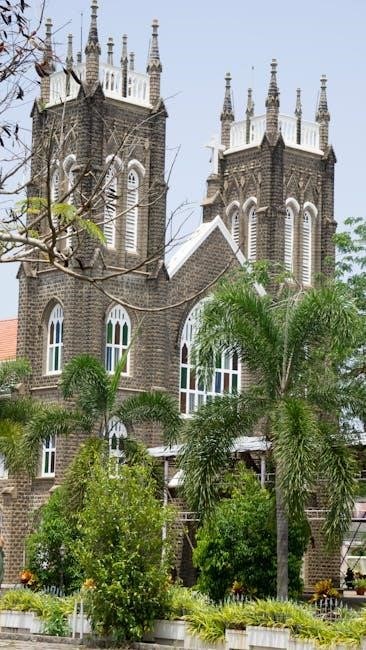Palm Springs is a mecca for architecture enthusiasts, offering self-guided tours that showcase its iconic mid-century modern designs, historic landmarks, and the works of renowned architects like Albert Frey and Richard Neutra․ Visitors can explore the city’s unique blend of Desert Modernism and organic architecture at their own pace, discovering the homes of Hollywood legends and the innovative structures that define this desert oasis․
Overview of Palm Springs’ Architectural Significance
Palm Springs is a hub of architectural innovation, boasting a unique concentration of mid-century modern and Desert Modernist designs․ The city’s arid landscape inspired architects like Albert Frey and Richard Neutra to create structures that blend seamlessly with the environment․ Its reputation as a Hollywood retreat in the 1950s and ’60s attracted legendary designers, resulting in iconic homes and landmarks․ Today, Palm Springs is a living museum of modernist architecture, offering a glimpse into a bygone era of design excellence and continuing to influence contemporary architectural practices․
Why Choose a Self-Guided Tour?
A self-guided architecture tour in Palm Springs offers unparalleled flexibility and personalization․ Visitors can explore iconic mid-century modern homes, landmarks, and neighborhoods at their own pace, allowing for a deeper immersion into the city’s architectural heritage․ With readily available maps, apps, and guides, planning is straightforward․ This option is ideal for those seeking an independent, cost-effective, and convenient way to discover the works of legendary architects like Albert Frey and Richard Neutra․ It’s perfect for photography enthusiasts, history buffs, and anyone eager to craft a unique, unforgettable experience tailored to their interests and schedule;

Notable Architects and Their Contributions
Pioneers like Albert Frey, Donald Wexler, Richard Neutra, and E․ Stewart Williams defined Palm Springs’ architectural identity with groundbreaking designs blending modernism, functionality, and desert aesthetics․
Albert Frey: The “Desert Modernist”
Albert Frey, a Swiss-born architect, left an indelible mark on Palm Springs with his innovative “Desert Modernism” style․ Known for harmonizing structures with their surroundings, Frey designed the iconic Palm Springs Visitor Center and Frey House II, a mountainside retreat․ His work emphasizes natural light, minimalism, and integration of the desert landscape․ Frey’s designs are celebrated for their functionality and aesthetic brilliance, making him a cornerstone of the city’s architectural identity․ His contributions remain a focal point for enthusiasts exploring Palm Springs’ modernist heritage through self-guided tours․
Donald Wexler: Master of Steel Development Houses
Donald Wexler, a prominent Palm Springs architect, revolutionized residential design with his innovative Steel Development Houses․ These structures, built in the 1960s, showcased Wexler’s expertise in combining functionality with modern aesthetics․ Designed as affordable yet stylish homes, they featured prefab steel frames, large windows, and open floor plans․ Wexler’s work blended seamlessly with the desert landscape, emphasizing minimalism and harmony with nature․ His contributions to Palm Springs’ architectural legacy are still celebrated today, with many of his homes preserved as iconic examples of mid-century modern design․ Wexler’s steel houses remain a highlight for those exploring the city’s architectural gems․
Richard Neutra: Pioneer of Modernist Architecture
Richard Neutra, a visionary architect, left an indelible mark on Palm Springs with his modernist designs that harmonized with the desert environment․ Known for his emphasis on functionality and natural light, Neutra’s homes featured expansive windows, open spaces, and a seamless connection between indoors and outdoors․ His work epitomized the principles of mid-century modern architecture, blending simplicity with elegance․ Neutra’s innovative approach to design influenced generations of architects, making his creations a cornerstone of Palm Springs’ architectural heritage․ His homes remain a must-see destination for anyone exploring the city’s modernist treasures on a self-guided tour․
E․ Stewart Williams: Iconic Designs in Palm Springs
E․ Stewart Williams, a prominent architect, left a lasting legacy in Palm Springs through his iconic designs that blend functionality with elegance․ His work, including the Palm Springs Art Museum, showcases his ability to create spaces that harmonize with the desert landscape․ Williams’ designs often featured clean lines, minimal ornamentation, and an emphasis on natural light, reflecting the modernist principles that define the city’s architectural identity․ His contributions to Palm Springs’ cultural and visual landscape make his buildings a highlight for those exploring the city’s architectural gems on a self-guided tour․
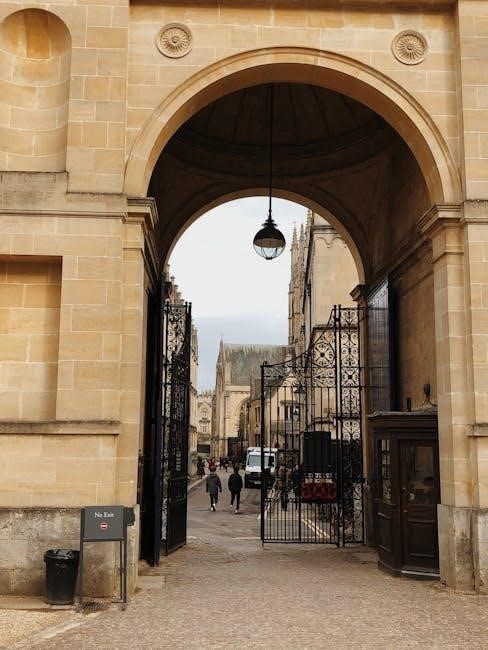
Famous Buildings and Homes to Explore
Palm Springs boasts iconic buildings like the Kaufmann House, Palm Springs Art Museum, and Frey House II, each showcasing mid-century modern and desert modernist architectural brilliance, attracting global admiration․
Kaufmann House: A Mid-Century Modern Icon
The Kaufmann House, designed by Richard Neutra in 1947, is a quintessential mid-century modern masterpiece․ Known for its seamless integration with the desert landscape, the house features floor-to-ceiling windows and sliding glass doors that blur the boundaries between indoors and outdoors․ Its minimalist design, open spaces, and emphasis on natural light exemplify the principles of Desert Modernism․ A must-see for architecture enthusiasts, the Kaufmann House is a testament to Neutra’s innovative approach and remains one of Palm Springs’ most iconic architectural treasures, attracting visitors on self-guided tours exploring the city’s design heritage․
Palm Springs Art Museum: A Blend of Art and Architecture
The Palm Springs Art Museum is a cultural gem that seamlessly merges art and architecture, offering a unique experience for visitors․ Designed by E․ Stewart Williams, the museum’s striking architecture complements its surroundings while housing a diverse collection of contemporary and modern art․ As part of self-guided tours, the museum provides insight into the city’s artistic heritage, showcasing works by regional and international artists․ Its sleek, modern design and rotating exhibits make it a must-visit destination, reflecting Palm Springs’ commitment to both artistic expression and architectural innovation․
Frey House II: A Mountain Retreat with Stunning Views
Frey House II, designed by Albert Frey, is a masterful blend of modernist architecture and natural surroundings․ Perched on a mountain, this retreat offers breathtaking views of Palm Springs․ The house exemplifies Frey’s “desert modernism” style, with floor-to-ceiling windows and an open floor plan that seamlessly integrates indoor and outdoor spaces․ Built in 1964, it serves as a prime example of how architecture can harmonize with nature․ As part of self-guided tours, visitors can explore this iconic property, gaining insight into Frey’s innovative design philosophy and its enduring influence on Palm Springs’ architectural landscape․
The Riviera Resort: A Mid-Century Modern Landmark
The Riviera Resort is a quintessential mid-century modern landmark in Palm Springs, epitomizing the city’s architectural heritage․ Designed by prominent architects, this iconic property features retro glamour, with its sprawling layout, geometric lines, and seamless integration of indoor-outdoor spaces․ The resort’s design emphasizes functionality and sophistication, reflecting the era’s minimalist aesthetic․ As part of self-guided tours, visitors can admire its dramatic entrances, lush landscaping, and vibrant atmosphere․ The Riviera Resort remains a symbol of Palm Springs’ mid-century modern movement, offering a glimpse into its rich architectural and cultural history while continuing to inspire design enthusiasts today․
Self-Guided Tour Options
Explore Palm Springs’ architectural gems through self-guided mid-century modern, Desert Modernism, or downtown walking tours․ Use maps, apps, or bike rentals for a flexible, immersive experience․
Mid-Century Modern Architecture Tour
Discover Palm Springs’ iconic mid-century modern architecture on a self-guided tour featuring homes designed by legendary architects like Albert Frey, Richard Neutra, and Donald Wexler․ This style, characterized by clean lines, open spaces, and seamless integration with the desert landscape, defines the city’s architectural identity․ Explore the Kaufmann House, a masterpiece of mid-century design, and other historic properties that showcase innovative use of steel, glass, and natural materials․ Use detailed maps or apps to navigate the tour, which highlights the timeless elegance and functionality of these landmarks․ Ideal for architecture enthusiasts, this tour offers a glimpse into Palm Springs’ design legacy․
Desert Modernism Tour
The Desert Modernism Tour highlights Palm Springs’ unique architectural style, blending functionality with desert aesthetics․ This self-guided journey explores iconic homes and buildings that embody the principles of Desert Modernism, such as the Kaufmann House and Frey House II․ Designed by architects like Albert Frey and Richard Neutra, these structures feature natural materials, minimalist designs, and seamless integration with the desert landscape․ Visitors can use detailed maps or apps to navigate the tour, discovering how Desert Modernism reflects the region’s cultural and environmental influences․ Perfect for architecture enthusiasts, this tour offers a deeper understanding of Palm Springs’ design identity and heritage․
Walking Tours of Downtown Palm Springs
Walking tours of downtown Palm Springs offer a charming way to explore the city’s architectural gems at a leisurely pace․ Stroll through the historic district and discover iconic buildings like the Palm Springs Art Museum and the Kaufmann House․ These tours allow visitors to appreciate the blend of mid-century modern and contemporary designs up close․ Maps and guides are available to highlight key landmarks, while the city’s pedestrian-friendly layout makes navigation easy․ Perfect for those who enjoy immersive experiences, these tours provide insight into Palm Springs’ cultural and architectural evolution․ A self-guided walking tour is ideal for capturing the city’s vibrant spirit․
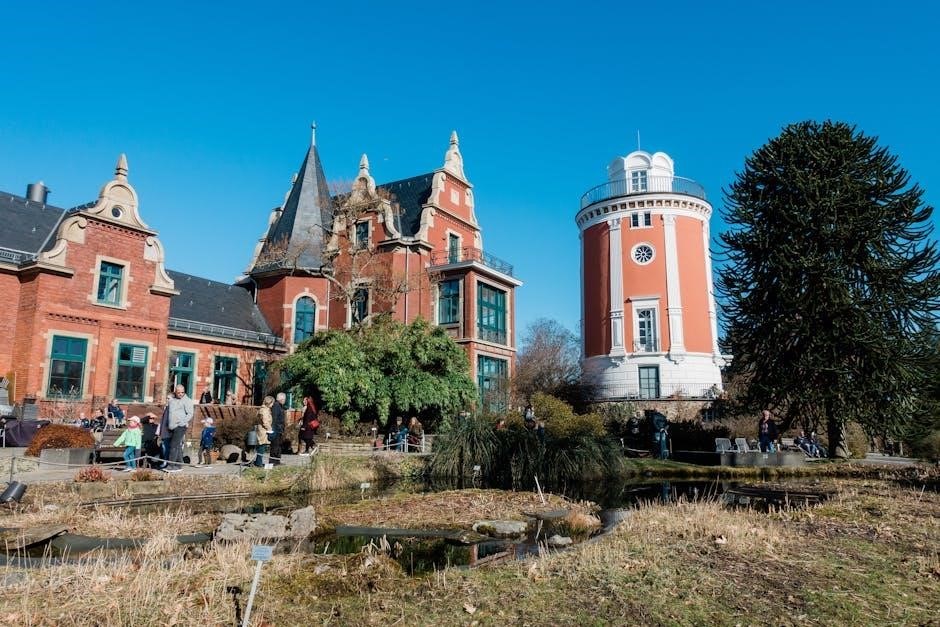
How to Plan Your Self-Guided Tour
Plan your self-guided tour with maps, guides, and apps․ Visit the Palm Springs Visitor Center for resources and start your architectural journey․
Best Time to Visit for Optimal Viewing
The best time for a self-guided architecture tour in Palm Springs is from October to May, when mild temperatures and clear skies provide ideal conditions for exploring․ Early mornings or late afternoons are perfect for photography, with soft lighting enhancing the mid-century modern designs․ Plan around popular events like Modernism Week in February, which celebrates the city’s architectural heritage but may attract larger crowds․ Avoid the intense desert heat of summer for a more comfortable experience․ Check local event calendars to align your visit with architectural festivals or open-house tours for added insights into the city’s design legacy․
Essential Tools: Maps, Guides, and Apps
For a seamless self-guided architecture tour in Palm Springs, equip yourself with detailed maps, guides, and apps․ Download the Palm Springs Modern app or use Google Maps for GPS-guided navigation to iconic sites․ Printable maps and brochures from the Palm Springs Visitor Center provide valuable insights and routes․ Online guides highlight must-see homes and landmarks, ensuring you don’t miss key attractions․ Apps like “Mid-Century Modern Architecture” offer in-depth information on architects and designs․ These tools help you efficiently explore the city’s architectural gems, ensuring a well-organized and enriching experience without missing any hidden treasures․
Transportation Options: Car, Bike, or Walking
Exploring Palm Springs’ architecture is convenient with various transportation options․ A car allows you to cover extensive distances and access remote locations easily․ Biking offers an eco-friendly, immersive way to discover neighborhoods like the Movie Colony at a leisurely pace․ Walking is ideal for shorter routes, such as downtown, letting you admire details up close․ Rentals are readily available for bikes and cars․ Choose the method that suits your tour style, ensuring comfort and hydration in the desert climate․ Each option provides a unique perspective, making your self-guided tour enjoyable and tailored to your preferences․
Exploring the Neighborhoods
Palm Springs’ neighborhoods offer a diverse architectural experience, from the Movie Colony’s historic homes to Indian Canyons’ natural beauty and Warm Sands’ modernist gems, each area unique and captivating․
The Movie Colony: Homes of Old Hollywood Stars
The Movie Colony, a historic neighborhood in Palm Springs, is renowned for its mid-century modern homes once owned by Hollywood legends․ Visitors can explore the exteriors of these iconic properties, capturing the essence of Old Hollywood’s glamour․ The area offers a glimpse into the lives of stars who sought refuge in Palm Springs’ serene desert landscape․ Self-guided tours allow architecture enthusiasts to admire the timeless designs, take memorable photos, and immerse themselves in the neighborhood’s rich cultural history․ Walking or driving through the Colony provides a unique opportunity to experience the architectural brilliance and storied past of this celebrity-favored enclave․
Indian Canyons: A Mix of Nature and Architecture
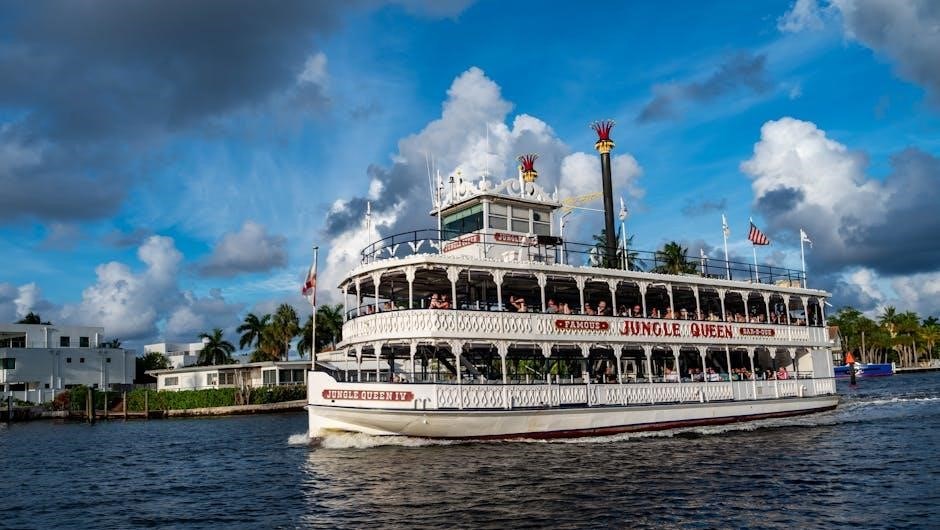
Indian Canyons, a natural oasis near Palm Springs, offers a unique blend of stunning landscapes and architectural intrigue․ Visitors can explore the ancient palm oases, hiking trails, and the historic Tahquitz House, a blend of traditional Native American and modern design․ The canyons, part of the Agua Caliente Indian Reservation, provide a serene escape from the city while showcasing the area’s rich cultural and natural heritage․ Self-guided tours allow guests to appreciate the harmonious coexistence of nature and architecture, making it a must-visit destination for those seeking both outdoor beauty and historical significance in the Palm Springs area․
Warm Sands: Modernist Gems in a Quiet Neighborhood
Warm Sands, a serene Palm Springs neighborhood, is a treasure trove of mid-century modern architecture․ Known for its peaceful atmosphere, the area features iconic homes designed by architectural legends like Albert Frey and Donald Wexler․ The neighborhood is home to the historic Frey House II, a masterpiece of Desert Modernism, blending seamlessly into its natural surroundings․ Visitors on self-guided tours can admire the clean lines, open spaces, and innovative use of materials that define these modernist gems․ Warm Sands offers a tranquil setting to explore some of Palm Springs’ most celebrated architectural achievements, making it a must-visit for design enthusiasts․
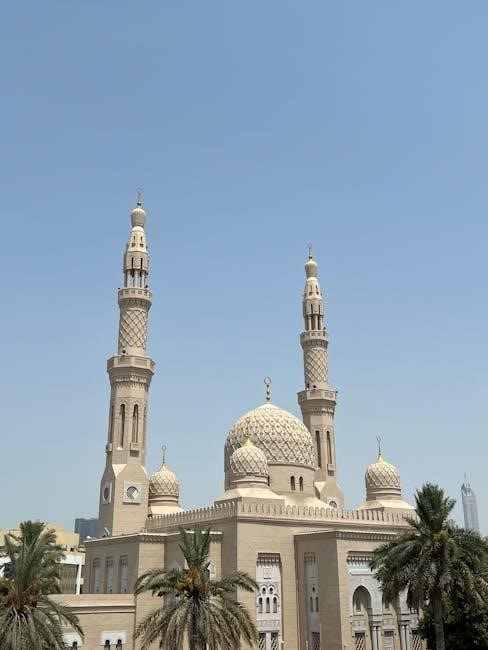
Architectural Styles to Look Out For
Discover Palm Springs’ iconic mid-century modern, Desert Modernism, and organic architecture styles, each blending functionality with aesthetic harmony, reflecting the city’s unique design legacy․
Mid-Century Modern: Clean Lines and Open Spaces
Mid-Century Modern architecture in Palm Springs is defined by its clean lines, open spaces, and seamless integration with the natural desert landscape․ This style, popularized in the 1950s and ’60s, emphasizes minimalist designs, large windows, and a focus on indoor-outdoor living․ Iconic architects like Albert Frey and Richard Neutra pioneered this movement, creating homes that blend functionality with elegance․ Notable examples include the Kaufmann House and homes designed by Donald Wexler․ Visitors on self-guided tours can admire the geometric simplicity, abundant natural light, and innovative use of materials that characterize Mid-Century Modern structures, making them timeless symbols of Palm Springs’ architectural heritage․
Desert Modernism: Functionality Meets Aesthetics
Desert Modernism in Palm Springs combines sleek, minimalist designs with practicality, blending seamlessly into the arid landscape․ Characterized by large windows, open floor plans, and natural materials, this style emphasizes harmony between form and function․ Architects like Albert Frey and Donald Wexler pioneered this approach, creating structures that adapt to the desert environment while maintaining a sophisticated aesthetic․ Self-guided tours allow visitors to explore these iconic buildings, appreciating how Desert Modernism balances durability, sustainability, and visual appeal, making it a cornerstone of Palm Springs’ architectural identity and a testament to innovative design in a unique setting․
Organic Architecture: Harmony with the Environment
Organic architecture in Palm Springs emphasizes harmony between buildings and their natural surroundings, blending structures with the desert landscape․ This style, popularized by architects like Frank Lloyd Wright, features curved lines, natural materials, and designs that mimic the organic forms of nature․ Homes and buildings seem to grow from the earth, creating a seamless transition between indoors and outdoors․ Self-guided tours allow visitors to explore these unique spaces, appreciating how organic architecture respects and enhances the desert environment while offering functional and aesthetically pleasing living spaces that resonate with the beauty of Palm Springs․

Historic Landmarks and Their Stories
Palm Springs’ historic landmarks offer a glimpse into its architectural heritage and cultural history, with each site telling a story of innovation and timeless design․
The Palm Springs Visitor Center: A Historic Icon
The Palm Springs Visitor Center stands as a historic landmark, offering a gateway to the city’s architectural heritage․ This iconic building is a prime example of mid-century modern design, reflecting the city’s commitment to innovative architecture․ As a starting point for self-guided tours, it provides essential maps, guides, and insights into Palm Springs’ architectural gems․ The center’s retro aesthetic and functional design make it a must-visit for anyone exploring the city’s design legacy, blending seamlessly into the desert landscape while showcasing the region’s cultural and historical significance․
The Cornelia White House: Oldest Home in Palm Springs
The Cornelia White House, built in 1893, is the oldest home in Palm Springs and a significant historical landmark․ This charming adobe-style structure offers a glimpse into the city’s early settlers’ lives, showcasing a blend of traditional and desert-adapted architecture․ As a key stop on self-guided tours, it highlights Palm Springs’ rich cultural heritage․ Visitors can admire its simple yet enduring design, which contrasts beautifully with the mid-century modernism prevalent elsewhere in the city․ The house stands as a testament to the region’s pioneering spirit and its transformation into a desert oasis․
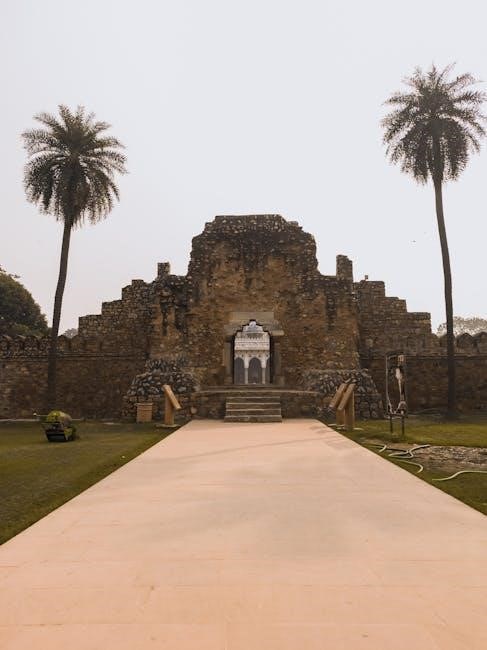
Tips for a Successful Self-Guided Tour
Plan your self-guided tour with maps, apps, and guides to navigate efficiently․ Respect private properties, stay hydrated, and wear sunscreen for a comfortable and enjoyable experience․
Respecting Private Properties: Dos and Don’ts
When exploring Palm Springs’ architectural gems, always respect private properties․ Admire homes from public sidewalks or designated viewing areas․ Use maps and apps to stay on track and avoid trespassing․ Refrain from entering private yards or taking unauthorized photos of residences․ Be mindful of “No Trespassing” signs and respect homeowner privacy․ Follow local guidelines to ensure a positive experience for both visitors and residents․ By being considerate, you help preserve access to these iconic sites for future enthusiasts while appreciating the city’s architectural heritage responsibly․
Photography Tips: Capturing the Perfect Shot
When photographing Palm Springs’ iconic architecture, timing is key—capture buildings during the golden hour for soft, warm lighting․ Use a polarizing filter to enhance colors and reduce glare․ Experiment with angles, shooting from low or high perspectives to emphasize design elements․ Include surrounding landscapes or details like desert plants to add context; Respect private properties and avoid trespassing․ Focus on unique architectural features, such as clean lines or geometric patterns․ Consider using a tripod for stability, especially during early morning or late afternoon shoots․ Take multiple shots to ensure the perfect frame, preserving memories of this architectural oasis․
Staying Hydrated and Comfortable in the Desert Heat
Exploring Palm Springs’ architecture requires preparation for the desert climate․ Stay hydrated by carrying a reusable water bottle and drinking regularly․ Wear lightweight, breathable clothing, a wide-brimmed hat, and apply broad-spectrum sunscreen to protect against the sun․ Plan your tour during cooler morning or late afternoon hours to avoid peak heat․ Bring a cooling towel or portable fan for extra comfort․ Wear comfortable walking shoes and consider bringing a shaded umbrella for added protection․ Ensure your vehicle is well-ventilated and stocked with water and snacks for continuous refreshment․ Prioritizing comfort allows you to fully enjoy the architectural wonders without fatigue․
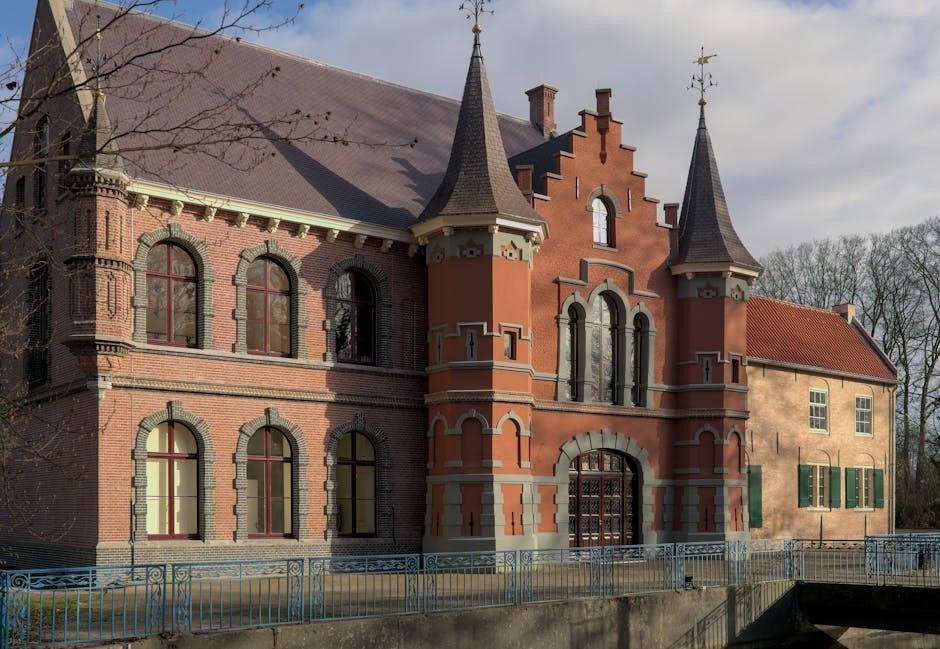
Cultural and Historical Significance
Palm Springs’ architecture reflects its rich cultural history, shaped by the Rat Pack era and Hollywood’s influence, making it a timeless destination for design and nostalgia enthusiasts․
Palm Springs and the Rat Pack Era
Palm Springs became a playground for the Rat Pack, a group of entertainers including Frank Sinatra, Dean Martin, and Sammy Davis Jr․, who frequented the city in the 1950s and ’60s․ Their presence left a lasting cultural impact, shaping the city’s vibrant nightlife and architectural landscape․ Many mid-century modern homes and retro-style lounges were built during this era, reflecting the glamour and sophistication of the Rat Pack’s lifestyle․
Today, self-guided tours allow visitors to explore these iconic locations, such as Frank Sinatra’s Twin Palms estate and the legendary Purple Room, where the Rat Pack once performed․ This era’s legacy continues to captivate architecture enthusiasts and history buffs alike․
The Role of Hollywood in Shaping Local Architecture
Hollywood’s influence on Palm Springs’ architecture is undeniable, as the city became a retreat for stars seeking privacy and luxury․ Many iconic homes were designed specifically for celebrities, blending mid-century modern aesthetics with desert practicality․ Architects like Albert Frey and Richard Neutra collaborated with Hollywood clients, creating spaces that reflected their glamorous lifestyles․ The demand for modern, open-concept homes with seamless indoor-outdoor living drove the development of Desert Modernism․ Today, self-guided tours allow visitors to explore these legendary properties, offering a glimpse into Hollywood’s enduring impact on Palm Springs’ architectural identity․
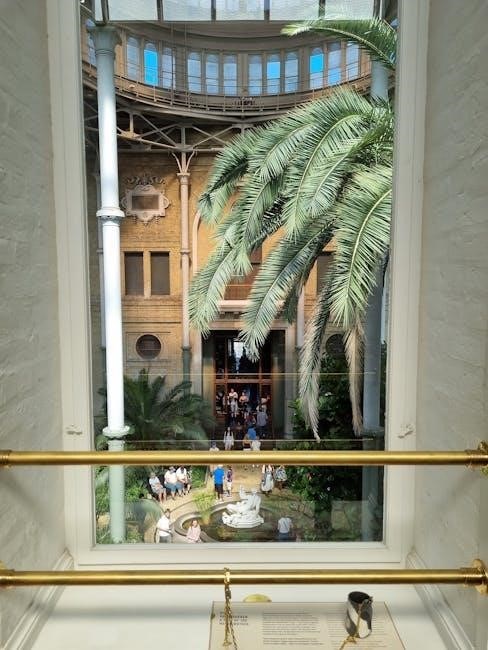
Additional Attractions and Activities
- Explore Joshua Tree National Park, a stunning natural wonder near Palm Springs․
- Visit the Palm Springs Art Museum to discover diverse art exhibits and collections․
Joshua Tree National Park: A Nearby Natural Wonder
Joshua Tree National Park offers a breathtaking escape from Palm Springs’ architectural wonders, showcasing unique rock formations, hiking trails, and diverse flora and fauna․ Located just a short drive away, it provides an ideal complement to your self-guided architecture tour․ Visitors can explore the park’s natural beauty at their own pace, capturing stunning photographs or simply enjoying the serene desert landscape․ The park’s scenic drives and trails allow for a peaceful retreat, blending nature with the mid-century modern aesthetic of Palm Springs․ It’s a perfect addition to your itinerary, offering a refreshing contrast to the city’s architectural gems․
Palm Springs Art Museum: Exhibits and Collections
The Palm Springs Art Museum is a cultural gem offering a diverse range of exhibits and collections that celebrate local and international art․ With rotating exhibitions, the museum provides insights into contemporary and modern art, as well as works by regional artists․ Visitors can explore the museum’s galleries, which often feature installations that complement the city’s architectural heritage․ The museum also hosts educational programs and events, making it a vibrant cultural destination․ Whether you’re an art enthusiast or simply looking to enrich your self-guided tour experience, the Palm Springs Art Museum offers a unique perspective on creativity and design․
A self-guided architecture tour in Palm Springs offers a unique journey through iconic designs, rich history, and cultural significance․ Explore, discover, and immerse yourself in this architectural paradise․
Final Thoughts on the Self-Guided Architecture Tour Experience
Embarking on a self-guided architecture tour in Palm Springs is an unforgettable journey through a city celebrated for its mid-century modern designs and historic landmarks․ Visitors gain a deeper appreciation for the works of visionary architects like Albert Frey and Richard Neutra, while exploring iconic homes such as the Kaufmann House․ The flexibility of these tours allows for a personalized experience, enabling travelers to connect with the city’s unique blend of Desert Modernism and organic architecture․ With maps, apps, and scenic routes at your disposal, this adventure promises inspiration, discovery, and a lasting admiration for Palm Springs’ architectural legacy․
